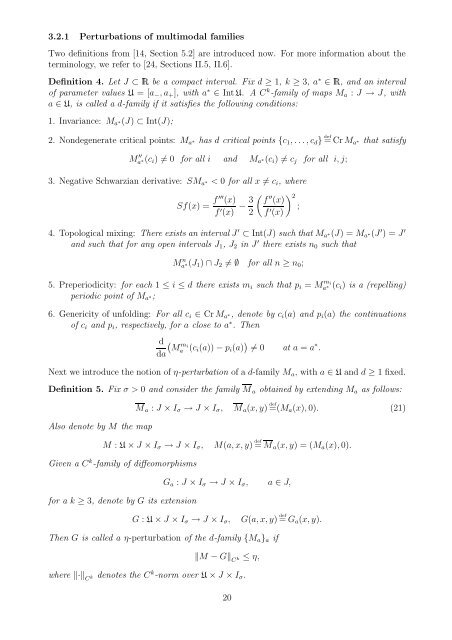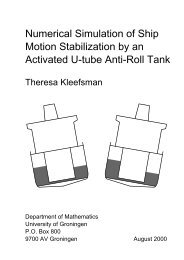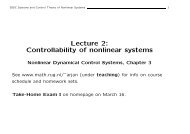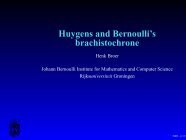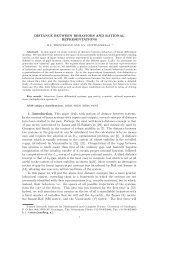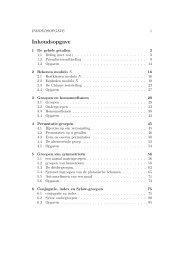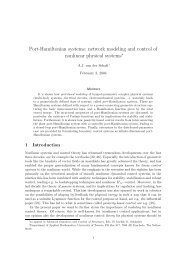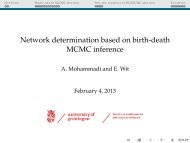Chaos and quasi-periodicity in diffeomorphisms of the solid torus
Chaos and quasi-periodicity in diffeomorphisms of the solid torus
Chaos and quasi-periodicity in diffeomorphisms of the solid torus
Create successful ePaper yourself
Turn your PDF publications into a flip-book with our unique Google optimized e-Paper software.
3.2.1 Perturbations <strong>of</strong> multimodal families<br />
Two def<strong>in</strong>itions from [14, Section 5.2] are <strong>in</strong>troduced now. For more <strong>in</strong>formation about <strong>the</strong><br />
term<strong>in</strong>ology, we refer to [24, Sections II.5, II.6].<br />
Def<strong>in</strong>ition 4. Let J ⊂ be a compact <strong>in</strong>terval. Fix d ≥ 1, k ≥ 3, a ∗ ∈ , <strong>and</strong> an <strong>in</strong>terval<br />
<strong>of</strong> parameter values U = [a − , a + ], with a ∗ ∈ Int U. A C k -family <strong>of</strong> maps M a : J → J, with<br />
a ∈ U, is called a d-family if it satisfies <strong>the</strong> follow<strong>in</strong>g conditions:<br />
1. Invariance: M a ∗(J) ⊂ Int(J);<br />
2. Nondegenerate critical po<strong>in</strong>ts: M a ∗ has d critical po<strong>in</strong>ts {c 1 , . . . , c d } def<br />
= Cr M a ∗ that satisfy<br />
M ′′<br />
a ∗(c i) ≠ 0 for all i <strong>and</strong> M a ∗(c i ) ≠ c j for all i, j;<br />
3. Negative Schwarzian derivative: SM a ∗ < 0 for all x ≠ c i , where<br />
Sf(x) = f ′′′ (x)<br />
f ′ (x) − 3 ( ) f ′′ 2<br />
(x)<br />
;<br />
2 f ′ (x)<br />
4. Topological mix<strong>in</strong>g: There exists an <strong>in</strong>terval J ′ ⊂ Int(J) such that M a ∗(J) = M a ∗(J ′ ) = J ′<br />
<strong>and</strong> such that for any open <strong>in</strong>tervals J 1 , J 2 <strong>in</strong> J ′ <strong>the</strong>re exists n 0 such that<br />
M n a ∗(J 1) ∩ J 2 ≠ ∅ for all n ≥ n 0 ;<br />
5. Pre<strong>periodicity</strong>: for each 1 ≤ i ≤ d <strong>the</strong>re exists m i such that p i = M m i<br />
a ∗ (c i) is a (repell<strong>in</strong>g)<br />
periodic po<strong>in</strong>t <strong>of</strong> M a ∗;<br />
6. Genericity <strong>of</strong> unfold<strong>in</strong>g: For all c i ∈ Cr M a ∗, denote by c i (a) <strong>and</strong> p i (a) <strong>the</strong> cont<strong>in</strong>uations<br />
<strong>of</strong> c i <strong>and</strong> p i , respectively, for a close to a ∗ . Then<br />
d (<br />
M<br />
m i<br />
a<br />
da<br />
(c i(a)) − p i (a) ) ≠ 0 at a = a ∗ .<br />
Next we <strong>in</strong>troduce <strong>the</strong> notion <strong>of</strong> η-perturbation <strong>of</strong> a d-family M a , with a ∈ U <strong>and</strong> d ≥ 1 fixed.<br />
Def<strong>in</strong>ition 5. Fix σ > 0 <strong>and</strong> consider <strong>the</strong> family M a obta<strong>in</strong>ed by extend<strong>in</strong>g M a as follows:<br />
M a : J × I σ → J × I σ ,<br />
M a (x, y) def<br />
=(M a (x), 0). (21)<br />
Also denote by M <strong>the</strong> map<br />
M : U × J × I σ → J × I σ ,<br />
M(a, x, y) def<br />
= M a (x, y) = (M a (x), 0).<br />
Given a C k -family <strong>of</strong> <strong>diffeomorphisms</strong><br />
for a k ≥ 3, denote by G its extension<br />
G a : J × I σ → J × I σ , a ∈ J,<br />
G : U × J × I σ → J × I σ ,<br />
G(a, x, y) def<br />
= G a (x, y).<br />
Then G is called a η-perturbation <strong>of</strong> <strong>the</strong> d-family {M a } a if<br />
‖M − G‖ C k ≤ η,<br />
where ‖·‖ C k denotes <strong>the</strong> C k -norm over U × J × I σ .<br />
20


